Kings and Demons: Francisco Goya [Scroll over each picture for information]
In this series I will be examining art and artists whose works have been used in metal band artwork or whose themes have been source for inspiration for metal musicians. The first artist is Francisco Goya of Spain, whose later works have been found on album covers for Anaal Nathrakh, Belsebub, Amon, Mortem, Torgeist and others.
I feel strongly that to truly appreciate art – visual or otherwise – that it is important to understand its context. Goya’s life and and the time period in which he lived made him one of the world’s most influential and important artists. It is said that he was the primary artist that ushered in the Romanticism era and it was his attention to detail, even in the most graphic of subject matter, that shocked his contemporaries.
Francisco Goya was born in the late 1700s in Spain, during a very tumultuous period of time artistically and politically. His talent for art was recognized at a young age and he traveled to Rome to learn his craft from the masters there. Upon returning to his hometown in Spain as a young man, he created quite a reputation for himself by drinking, whoring, and brawling. His reputation preceded him when he fled to Madrid after killing a man in a bar fight and being sought by the Inquisition for his crime.
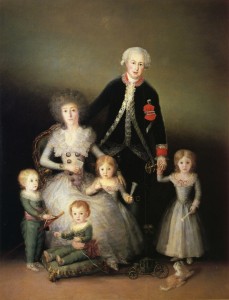
Arriving in Madrid, Goya was greeted by a city full of newly-minted aristocrats being placated by lazy “masters” selling them poorly painted Baroque style cherubs and nature scenes to decorate their palaces. Goya’s more realistic and new Romanticist style was a breath of fresh air to the stagnant art scene of the time and he quickly earned himself a top position as the official painter for the Spanish Royal Family.
In 1792 Goya was afflicted with an unknown illness that left him completely deaf. There has been wide speculation that it was lead poisoning from his paints that caused his illness, but there has been no evidence to support this theory and it is genuinely not considered to be valid by historians. Following the recovery from his illness, Goya returned to work for the Spanish Royal Court, becoming named the director of the Royal Academy in 1795.
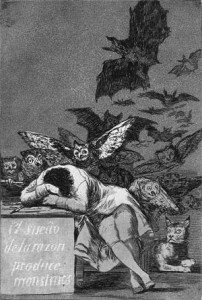
In the late 1790s in Spain and elsewhere in western Europe, political dissent and social unrest began to build. The French Revolution had reached its peak in 1789, and there the people revolted against the established monarchies and deposed of those in power. This dissent spread to Spain as well, and Goya, despite having been in the employ of the Monarchy, was well in tune with the plights of the common people.
In 1799 he released a series of 80 etchings known collectively as “Los Caprichos” (The Caprices), which is one of the first examples of Goya’s work turning darker. They were designed as social commentary against the rampant corruption, greed, and inequality he saw to draw attention to the struggles of the average Spaniard. These were published and then almost immediately withdrawn due to political pressure. The original printing plates and unsold prints were offered to the King to avoid the wrath of the Inquisition.
Goya’s political dissent began to creep into his “professional” works, as well. In 1800, he painted an official portrait of the Spanish royal family of King Charles IV.
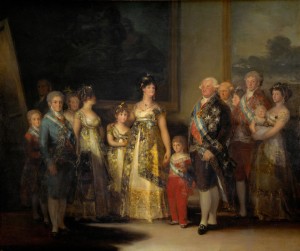
It was well-known, but not publicly discussed, that the Queen was the true head of the household, and to nod to this, she is positioned in the center and larger than the rest of the family. Goya himself is in this portrait, off to the left in the shadows behind the canvas. The queen and her mother (pictured fourth from the left) are depicted as quite ugly, and the whole family has been described as looking like common people who just won the lottery: bewildered and uncomfortable.
In 1808, Napoleon Bonaparte invaded Spain and installed his brother, Joseph, as ruler. Goya, surprisingly, was not cast out with the rest of the royal family and their staff, and continued to paint under Joseph Bonaparte during his seven year rule, until Spanish nobility, under King Ferdinand VII, regained power. King Ferdinand famously quipped to Goya, “you deserve to be garroted, but you are a great artist so we forgive you” and let him keep his position as court painter. Goya was tortured by what he had seen during the fighting and the conditions that the Spanish people were subjected to during the Napoleonic invasion and subsequent retaking of Spain by King Ferdinand during the Peninsular War. Similar to his Los Caprichos series, he released another series of sketches called Los Desastres de la Guerra (The Disasters of War) to depict these horrors with his characteristic sarcasm and cryptic descriptions. Others in this series depicted his dissatisfaction with Ferdinand’s rule, despite the great personal risk in doing so.
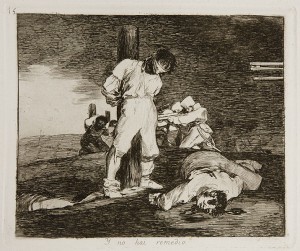
With the political climate only getting worse and his health in decline, Goya went into self-imposed exile in Bordeaux, France, in 1824 at the age of 72. He took with him only one servant and became a near recluse in the house that was known as Quinta del Sordo, or the Deaf Man’s Villa. Here he would paint his most famous paintings on the walls of his own house. Without titles and likely never intended for anyone to see, the works that are now known as The Black Paintings (for their technique as well as their subject matter) were never even titled by Goya; their names have all been given by historians. Exploring the subjects of the wars and the inquisitions, many of the Black Paintings had anti-clerical themes and were inspired by the fears brought out during the Inquisition.
One of the most famous of the Black Paintings is The Witches Sabbath, which depicts a goat-headed man wearing priest robes being feared and adored by a group of grotesque witches. At center is a woman wearing what appears to be a white nun’s habit. Mouths in particular are quite prominent in Goya’s works during this time; gaping, drooling, oversized and ugly, they are the center of expression on many of the faces in his scenes. To the right in this painting we see a woman seated in a chair, wearing black, seemingly uninterested and defiant. This painting represents what Goya felt was the cult of superstition whipped up during the Inquisition, the dangerous descent into medieval thinking and the suppression of scientific thought. The “he-goat” represents evil and the fawning witches represent the clerics and nuns in a frenzy over it. The lone dissenting woman represents the last bastion of reason, helplessly overlooking the fray.

Saturn Devouring One Of His Sons is a play on the Greek myth of the titan Saturn (Kronos) who, upon hearing a prophesy that he would be destroyed by one of his children, killed and devoured them as soon as they were born. Here, the eternal Titan represents royalty, and he – fearing his “children” (the common people) will ultimately turn on him, destroys them at their most vulnerable. Again in this piece we see Goya’s use of grotesque facial expressions in the oversized, gaping mouth rending the headless child to pieces.
Goya remained in Bordeaux until his death in 1828. His final works remained in his house for 50 years, until they were carefully removed and transferred to canvas. Works of his are still being discovered to this day, and can be viewed in museums and private collections around the world.
Tags: brutality in art, goya
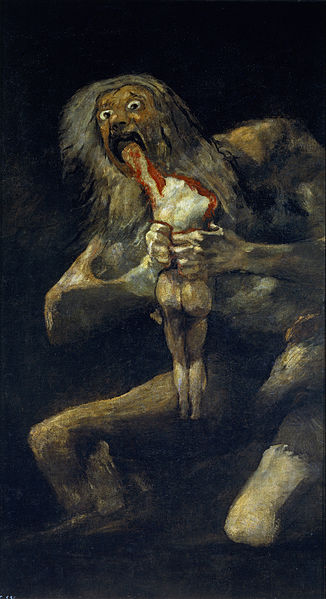


Thanks for the interesting and insightful read, and thank you again for addressing the paucity of literature that treats metal as a reincarnation of eternal themes that have been present in great art since the beginning.
Recommendation for the next chapter: Zdzisław Beksiński
https://www.google.com/search?q=beksinski&hl=en&safe=off&biw=1366&bih=624&um=1&ie=UTF-8&tbm=isch&source=og&sa=N&tab=wi&authuser=0&ei=_79JUYOAJsKmyQGu0YDwDA
This is great. I hate to agree with “Tralf” on anything, but it is good to see metal presented in the context of the great art of history. This more than anything else helps the mission of this site. It’s better than just talking about it, because it shows us.
Still trust me when I say that in a lonely grave somewhere, Goya does not want to be associated with Ilud Divanum Insanus.
Tr00. I don’t recall Goya having a phallus obsession.
Ha. Morbid Gerbil.